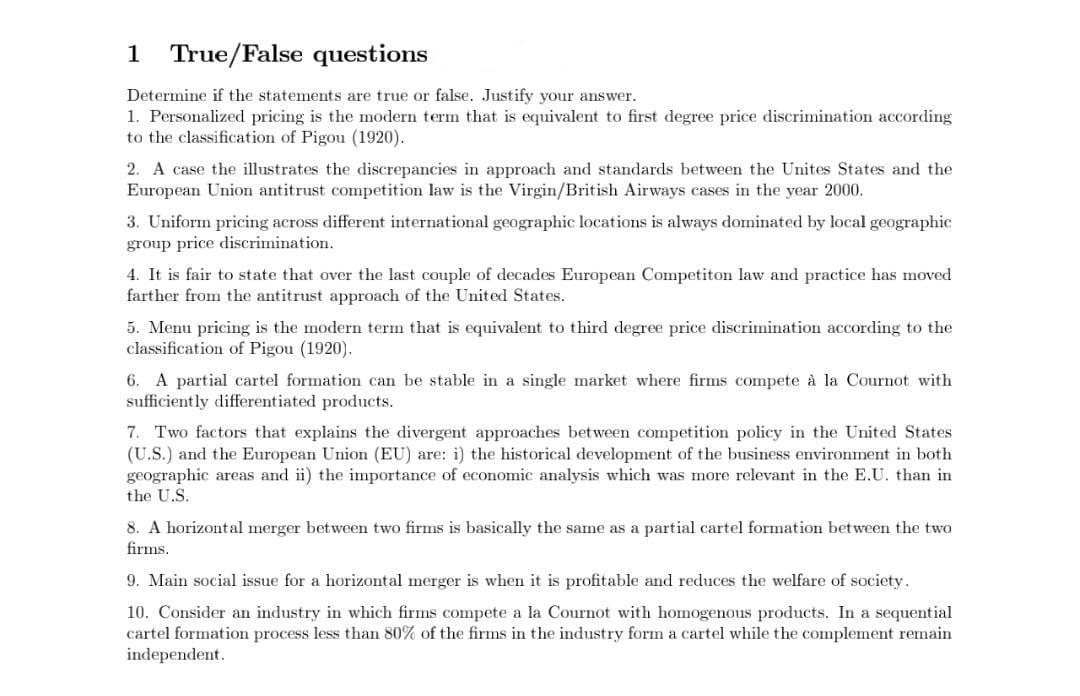Determine if the statements are true or false. Justify your answer. 1. Personalized pricing is the modern term that is equivalent to first degree price discrimination according to the classification of Pigou (1920). 2. A case the illustrates the discrepancies in approach and standards between the Unites States and the
Determine if the statements are true or false. Justify your answer. 1. Personalized pricing is the modern term that is equivalent to first degree price discrimination according to the classification of Pigou (1920). 2. A case the illustrates the discrepancies in approach and standards between the Unites States and the
Principles Of Marketing
17th Edition
ISBN:9780134492513
Author:Kotler, Philip, Armstrong, Gary (gary M.)
Publisher:Kotler, Philip, Armstrong, Gary (gary M.)
Chapter1: Marketing: Creating Customer Value And Engagement
Section: Chapter Questions
Problem 1.1DQ
Related questions
Question
solve 20-30 mins i'll give you multiple upvote( handwritten asap)

Transcribed Image Text:1
True/False questions
Determine if the statements are true or false. Justify your answer.
1. Personalized pricing is the modern term that is equivalent to first degree price discrimination according
to the classification of Pigou (1920).
2. A case the illustrates the discrepancies in approach and standards between the Unites States and the
European Union antitrust competition law is the Virgin/British Airways cases in the year 2000.
3. Uniform pricing across different international geographic locations is always dominated by local geographic
group price discrimination.
4. It is fair to state that over the last couple of decades European Competiton law and practice has moved
farther from the antitrust approach of the United States.
5. Menu pricing is the modern term that is equivalent to third degree price discrimination according to the
classification of Pigou (1920).
6. A partial cartel formation can be stable in a single market where firms compete à la Cournot with
sufficiently differentiated products.
7. Two factors that explains the divergent approaches between competition policy in the United States
(U.S.) and the European Union (EU) are: i) the historical development of the business environment in both
geographic areas and ii) the importance of economic analysis which was more relevant in the E.U. than in
the U.S.
8. A horizontal merger between two firms is basically the same as a partial cartel formation between the two
firms.
9. Main social issue for a horizontal merger is when it is profitable and reduces the welfare of society.
10. Consider an industry in which firms compete a la Cournot with homogenous products. In a sequential
cartel formation process less than 80% of the firms in the industry form a cartel while the complement remain
independent.
Expert Solution
This question has been solved!
Explore an expertly crafted, step-by-step solution for a thorough understanding of key concepts.
Step by step
Solved in 2 steps

Recommended textbooks for you

Principles Of Marketing
Marketing
ISBN:
9780134492513
Author:
Kotler, Philip, Armstrong, Gary (gary M.)
Publisher:
Pearson Higher Education,

Marketing
Marketing
ISBN:
9781259924040
Author:
Roger A. Kerin, Steven W. Hartley
Publisher:
McGraw-Hill Education

Foundations of Business (MindTap Course List)
Marketing
ISBN:
9781337386920
Author:
William M. Pride, Robert J. Hughes, Jack R. Kapoor
Publisher:
Cengage Learning

Principles Of Marketing
Marketing
ISBN:
9780134492513
Author:
Kotler, Philip, Armstrong, Gary (gary M.)
Publisher:
Pearson Higher Education,

Marketing
Marketing
ISBN:
9781259924040
Author:
Roger A. Kerin, Steven W. Hartley
Publisher:
McGraw-Hill Education

Foundations of Business (MindTap Course List)
Marketing
ISBN:
9781337386920
Author:
William M. Pride, Robert J. Hughes, Jack R. Kapoor
Publisher:
Cengage Learning

Marketing: An Introduction (13th Edition)
Marketing
ISBN:
9780134149530
Author:
Gary Armstrong, Philip Kotler
Publisher:
PEARSON


Contemporary Marketing
Marketing
ISBN:
9780357033777
Author:
Louis E. Boone, David L. Kurtz
Publisher:
Cengage Learning